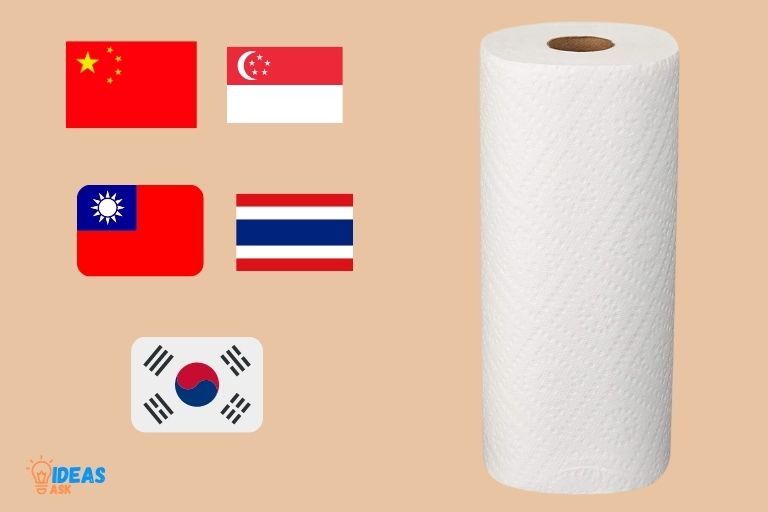What Countries Do Not Use Paper Towels? Japan, India, China
Countries that do not commonly use paper towels include Japan, India, China, and many European nations.
In these countries, paper towels are not prevalent due to cultural preferences, environmental concerns, and cost-effective alternatives.
People often prefer to use hand dryers, cloth towels, or simply air-drying their hands after washing. This is also supported by an increased focus on sustainability and reducing waste.
Cultural preferences and traditions play a significant role in the avoidance of paper towels in some countries.
For instance, Japanese people typically carry their own handkerchiefs or small towels, reducing the demand for paper towels in public spaces.
Additionally, the growing awareness of environmental issues has led to a stronger preference for hand dryers and reusable cloth towels in many countries, as they produce less waste and have a lower carbon footprint than paper towels.
10 Common Countries that Don’t Use Paper Towels
| Country | Paper Towel Usage |
|---|---|
| India | Rarely used |
| Japan | Rarely used |
| China | Rarely used |
| Nepal | Rarely used |
| Indonesia | Rarely used |
| Sri Lanka | Rarely used |
| Turkey | Rarely used |
| Kenya | Rarely used |
| Ethiopia | Rarely used |
| Bangladesh | Rarely used |
Key Takeaway

Five Facts About Countries that Don’t Use Paper Towels
A Look At The Global Impact Of Paper Towel Usage
Paper towels are a handy and effective way to clean up our messes, but they come at a significant environmental cost.
From trees being cut down to make paper pulp to the waste generated in the production and disposal of these towels, the environmental impact of paper towel usage is substantial.
Let’s take a closer look at some of the key points highlighting the negative impact of paper towel usage across the globe.
The Environmental Impact Of The Paper Industry
The paper industry is extremely resource-intensive and has a high environmental impact, especially in countries with low regulations and enforcement.
Here are some of the key points highlighting the environmental impact of the paper industry:
- Deforestation: The paper industry is one of the biggest drivers of deforestation globally. Each year, millions of hectares of forests are destroyed to make paper products.
- Water pollution: The paper industry is a significant source of water pollution, with mills releasing toxic chemicals into waterways.
- Greenhouse gas emissions: The paper industry is responsible for considerable greenhouse gas emissions, mainly because of the energy-intensive process involved in paper production.
The Rise Of Single-Use Plastics And Their Consequences
As the environmental impact of the paper industry continues to grow, we have seen a rise in the usage of single-use plastics, which also pose serious environmental problems.
Here are some of the key points highlighting the consequences of single-use plastics:
- Marine pollution: Single-use plastics are a significant source of marine pollution, with discarded plastic items, such as bags, bottles, and straws, often ending up in the ocean.
- Wildlife harm: Marine animals often mistake plastic for food, leading to injury or death, and microplastics have also been found in marine life, such as fish, which can have negative health implications for humans who consume them.
- Landfill waste: With single-use plastics being difficult to recycle, they often end up in landfills, where they can take hundreds of years to decompose.
The environmental impact of both paper towels and single-use plastics is significant and must be addressed if we are to create a sustainable future.
In our daily lives, we can make simple changes, such as using cloth towels instead of paper towels and bringing our reusable bags and containers when shopping. By taking small steps, we can all make a difference.
A Survey Of Countries With Sustainable Alternatives To Paper Towels
Japan: Embracing The Traditional Art Of Hand Drying
In japan, using paper towels are rare. They prefer traditional hand-drying methods that have been practiced for centuries.
Here are the key points about the traditional hand-drying methods in japan:
- Japanese use a cloth called “tenugui” for hand drying.
- The tenugui is a thin, cotton cloth that is long and narrow.
- It is multipurpose, and not just limited to hand drying.
- A tenugui is washable, reusable, and dries quickly.
- The japanese use tenugui for other things too, such as as bandanas, decoration, and even as gifts.
South Korea: A Culture Of Handkerchiefs And Cloth Rags
South koreans have a culture of carrying handkerchiefs and cloth rags instead of paper towels.
Here are the key points about south korea’s approach to hand drying:
- South koreans carry handkerchiefs in their bags or pockets.
- It is customary to offer a handkerchief to others when they need it.
- They also use cloth rags, which are washable and reusable.
- Using cloth rags is more hygienic than paper towels.
- South koreans also believe carrying cloth items shows respect towards the environment.
India: A Nation With A Long History Of Reusable Cloth Napkins
In india, they have used reusable cloth napkins for a very long time.
Here are the key points about india’s use of cloth napkins:
- Cloth napkins in india are called “gamcha” or “mundu”.
- They are made of cotton and are washable and reusable.
- Indians believe that using gamcha reduces waste and is eco-friendly.
- Gamcha can be used for other purposes too, such as wiping hands or face.
- Using cloth napkins is more economical than buying paper towels.
Several countries have sustainable alternatives to paper towels.
Japan embraces traditional hand-drying methods, south korea has a culture of using handkerchiefs and cloth rags, and in india, they have used reusable cloth napkins for a long time.
By adopting these eco-friendly practices, we can reduce our carbon footprint and respect the environment.
Japan: Embracing The Traditional Art Of Hand Drying
Japan is a country that focuses heavily on efficiency and sustainability in daily life. When it comes to hand drying, they have taken this approach to a whole new level by embracing the traditional art of oshibori.
We will explore the history of this unique hand drying method, its widespread usage in japan, and the benefits of using oshibori.
The History Of Oshibori: The Japanese Towel
Oshibori, also known as the japanese towel, has been used in japan for centuries as a way to clean hands before and after meals.
Originally made from cotton, the modern version is typically made from synthetic materials, making it more durable and easier to clean.
From High-End Restaurants To Convenience Stores: Oshibori Usage In Japan
Today, oshibori is ubiquitous in japan, and it can be found everywhere from high-end restaurants to convenience stores.
The towel is typically provided to customers at the beginning of a meal or when they enter a store. Some restaurants even have different scents or temperatures to provide a more personalized experience.
The Benefits Of Using Oshibori: Sustainability And Hygiene
Using oshibori has several benefits, including sustainability and hygiene.
Here are some of the key advantages of this traditional japanese hand drying method:
- Sustainability: By using oshibori instead of disposable paper towels, japan saves millions of trees and reduces waste every year.
- Hygiene: Oshibori is typically washed and reused, making it a more hygienic option than paper towels that can harbor bacteria.
- Cost-effective: While the upfront cost of purchasing oshibori towels may be higher, in the long run, it is more cost-effective as they can be washed and reused multiple times.
Oshibori is not just a traditional japanese towel, but a modern and practical solution to hand drying that prioritizes sustainability and hygiene.
Next time you visit japan, be sure to embrace this unique cultural experience and try oshibori for yourself.
South Korea: A Culture Of Handkerchiefs And Cloth Rags
South korea is a country passionate about sustainability and eco-friendliness.
With these values in mind, it’s not surprising to learn that paper towels are not a common sight in households and public places. Instead, south koreans have embraced a culture of handkerchiefs and cloth rags for various purposes.
Let’s delve deeper into the history and cultural significance of cloth rags in south korea, how they are used universally from schools to households, and the challenges and opportunities for expanding their usage.
The History And Cultural Significance Of Cloth Rags In South Korea:
- Cloth rags have a long history in korean culture, dating back to the days of the joseon dynasty in the 15th century.
- During that era, koreans used cloth rags to clean their hands before and after meals, as well as to wipe their faces and bodies.
- The tradition of using cloth rags continued to this day, with modern developments leading to the creation of microfiber cloths and washable fabric alternatives.
- Cloth rags have become a symbol of south korea’s commitment to environmental sustainability, proving that small changes can make a significant impact.
From Schools To Households: The Universality Of Cloth Rags In South Korea:
- In south korean schools, students are required to carry a handkerchief or cloth rag with them so that they can clean up after themselves.
- Public restrooms in south korea do not provide paper towels; instead, they have hand dryers and disposable cotton towels.
- Many south korean households have also eliminated the use of paper towels and have switched to using cloth rags or microfiber cloths for cleaning and wiping surfaces.
- Cloth rags are used for various purposes in south korea, such as wiping tables, cleaning dishes, and drying hands.
Challenges And Opportunities For Expanding Cloth Rag Usage:
- Despite the widespread use of cloth rags in south korea, there are still some areas where paper towels are used instead, such as in fast-food restaurants.
- One challenge for expanding cloth rag usage in south korea is the misconception that they are not as hygienic as single-use paper towels.
- However, studies have shown that when properly washed, cloth rags can be more effective in removing germs and bacteria than single-use paper towels.
- There is an opportunity to educate and encourage people to switch to cloth rags in public places and households, reducing waste and promoting sustainability.
South korea’s culture of using handkerchiefs and cloth rags is not only eco-friendly but also deeply rooted in history and tradition.
There are challenges to expanding their use, but with awareness and education, the country can lead the way in promoting sustainable habits.
India: A Nation With A Long History Of Reusable Cloth Napkins
India: a nation with a long history of reusable cloth napkins
India, known for its diverse cultural heritage and traditions, has a rich history of using reusable cloth napkins, also known as ‘gamchas’ or ‘gamochas,’ since ancient times.
The use of these napkins was prevalent in most households, especially in rural areas, where households were self-sufficient in producing the cloth napkins themselves.
We will explore the evolution of cloth napkins in india, current practices and trends in the use of cloth napkins, and the role of cultural norms and government policies in supporting sustainable alternatives.
The Evolution Of Cloth Napkins In India: From Handwoven To Mass-Produced
- Cloth napkins were originally handwoven using cotton or silk yarn before the advent of industrialization.
- Historically, textiles were produced using ‘charkhha’ or spinning wheels in households and were a symbol of the gandhian movement against mass-produced goods.
- With the introduction of mechanization and technology, handloom and power loom industries began producing cloth napkins on a large scale.
- Currently, most cloth napkins are made using power looms and are available in different sizes, colors, and patterns, catering to the growing demand and preference for reusable and eco-friendly products.
Current Practices And Trends In The Use Of Cloth Napkins In India
- India is one of the largest consumers and producers of cloth napkins globally, with an estimated market size of $3 billion in 2020.
- Cloth napkins are widely used in households, hospitality, and healthcare sectors, catering to a range of needs and preferences.
- The preference for cloth napkins varies by region, with southern and eastern india having a higher usage rate compared to the north.
- India has also seen a rise in the use of organic and biodegradable cloth napkins in recent years, catering to the growing demand for sustainable alternatives.
The Role Of Cultural Norms And Government Policies In Supporting Sustainable Alternatives
- In india, the use of cloth napkins is deeply embedded in cultural and religious practices, such as offering them to guests and using them during festivities, making it a sustainable choice.
- The indian government has played an integral role in promoting sustainable alternatives by launching initiatives such as swachh bharat abhiyan, which encourages the use of cloth napkins and discourages single-use products.
- The indian government has set up various textile parks and clusters, supporting the production of eco-friendly and biodegradable cloth napkins, and providing employment opportunities to many in the country.
India has a rich history of using reusable cloth napkins, which is deeply rooted in cultural and religious practices.
With changing times, india has adapted to mass-produced cloth napkins while still preserving its traditional methods.
The indian government’s initiatives and policies have also played an integral role in promoting sustainable alternatives, providing employment opportunities, and contributing to the country’s overall development.
FAQ On Countries that Don’t Use Paper Towels
Which Countries Use Hand Dryers Instead Of Paper Towels?
Several countries such as japan, south korea, and the united arab emirates widely use hand dryers instead of paper towels in public restrooms.
What Are The Alternatives To Paper Towels In The Kitchen?
Eco-friendly alternatives to paper towels in the kitchen include reusable cloth towels, sponges, and compostable paper towels made from recycled materials.
Why Are Paper Towels Bad For The Environment?
Paper towels contribute to deforestation, and their production requires a significant amount of energy and water. Additionally, they don’t break down easily in landfills.
Which Country Was The First To Invent The Paper Towel?
The united states was the first country to invent paper towels in 1907 by the scott paper company.
Conclusion
As we wrap up our exploration of countries that do not use paper towels, it is clear that this is a growing trend worldwide.
From japan’s use of handkerchiefs to turkey’s embrace of traditional cloth towels, these alternatives are not only more eco-friendly but can also be more cost-effective in the long term.
It is inspiring to see how different cultures have found unique solutions to reduce waste and protect the environment.
However, it is important to note that these alternatives may not work for everyone, and it ultimately comes down to personal preferences and circumstances.
In any case, it is clear that as we continue to search for ways to lessen our impact on the planet, exploring different cultural practices can provide valuable insights and inspiration. So next time you reach for a paper towel, consider if there’s a more sustainable option available.





